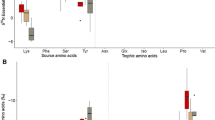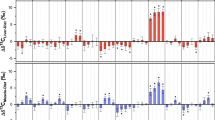Abstract
Stable isotope analysis is an increasingly valuable tool in ecological studies and shows promise as a measure of nutritional stress in wild animals. Thus far, however, the only studies on endotherms that have conclusively shown changes in δ15N and δ13C values in response to nutritional stress were conducted on fasting animals and animals growing under extreme levels of food restriction. We conducted a laboratory experiment to test whether δ15N and δ13C values provide a general index of nutritional stress. We compared the isotopic composition of whole blood, liver, muscle and feathers between two groups of juvenile song sparrows (Melospiza melodia) hand-reared in captivity under identical conditions except for feeding regime. To verify that our experimental treatment induced a biologically meaningful level of nutritional stress, we simultaneously measured the effects on physiology, growth and development at multiple scales. While food-restricted birds were physiologically stressed, physically smaller, and showed poorer growth and brain development compared to ad libitum-fed birds, there was no effect of feeding regime on either δ15N or δ13C values in any tissue. Instead of a continuum where the level of change in 15N or 13C contents corresponds to the level of nutritional stress, we suggest there may be a threshold level of nutritional stress below which such isotopic changes are likely to be negligible.

Similar content being viewed by others
References
Bearhop S, Hilton GM, Votier SC, Waldron S (2004) Stable isotope ratios indicate that body condition in migrating passerines is influenced by winter habitat. Proc R Soc Lond B 271:S215–S218
Bearhop S, Teece MA, Waldron S, Furness RW (2000) Influence of lipid and uric acid on δ13C and δ15N values of avian blood: implications for trophic studies. Auk 117:504–507
Ben-David M, McColl CJ, Boonstra R, Karels TJ (1999) 15N signatures do not reflect body conditions in arctic ground squirrels. Can J Zool 77:1373–1378
Bligh EG, Dyer WJ (1959) A rapid method of total lipid extraction and purification. Can J Biochem Physiol 37:911–917
Bortolotti GR, Dawson RD, Murza GL (2002) Stress during feather development predicts fitness potential. J Anim Ecol 71:333–342
Cherel Y, Hobson KA, Bailleul F, Groscolas R (2005) Nutrition, physiology, and stable isotopes: new information from fasting and molting penguins. Ecology 86:2881–2888
Christensen VL, Grimes JL, Donaldson WE, Lerner S (2000) Correlation of body weight with hatchling blood glucose concentration and its relationship to embryonic survival. Poult Sci 79:1817–1822
Clinchy M, Zanette L, Boonstra R, Wingfield JC, Smith JNM (2004) Balancing food and predator pressure induces chronic stress in songbirds. Proc R Soc Lond B 271:2473–2479
Doucett RR, Booth RK, McKinley RS (1999) Effects of the spawning migration on the nutritional status of anadromous atlantic salmon (Salmo salar): insights from stable-isotope analysis. Can J Fish Aquat Sci 56:2172–2180
Gannes LZ, del Rio CM, Koch P (1998) Natural abundance variation in stable isotopes and their potential uses in animal physiological ecology. Comp Biochem Physiol 119A:725–737
Gannes LZ, O’Brien DM, del Rio CM (1997) Stable isotopes in animal ecology: assumptions, caveats, and a call for more laboratory experiments. Ecology 78:1271–1276
Gil D, Heim C, Bulmer E, Rocha M, Puerta M, Nagiulo M (2004) Negative effects of early developmental stress on yolk testosterone levels in a passerine bird. J Exp Biol 207:2215–2220
Gloutney ML, Alisauskas RT, Hobson KA, Afton AD (1999) Use of supplemental food by breeding Ross’s geese and lesser snow geese: evidence for variable anorexia. Auk 116:97–108
Gorokhova E, Hansson S (1999) An experimental study on variations in stable carbon and nitrogen isotope fractionation during growth of Mysis mixta and Neomysis integer. Can J Fish Aquat Sci 56:2203–2210
Grieco F (2003) Greater food availability reduces tarsus asymmetry in nestling blue tits. Condor 105:599–603
Hatch KA, Sacksteder KA, Treichel IW, Cook ME, Porter WP (1995) Early detection of catabolic state via changes in 13C/12C ratios of blood proteins. Biochem Biophys Res Commun 212:719–725
Heath JA, Duffy AM Jr (1998) Body condition and the adrenal stress response in captive American kestrel juveniles. Physiol Zool 71:67–73
Hobson KA, Alisauskas RT, Clark RG (1993) Stable-nitrogen isotope enrichment in avian tissues due to fasting and nutritional stress: implications for isotopic analyses of diet. Condor 95:388–394
Hobson KA, Schell DM (1998) Stable carbon and nitrogen isotope patterns in baleen from eastern Arctic bowhead whales (Balaena mysticetus). Can J Fish Aquat Sci 55:2601–2607
Hovorka MD, Robertson RJ (2000) Food stress, nestling growth, and fluctuating asymmetry. Can J Zool 78:28–35
Jardine TD, Cunjak RA (2005) Analytical error in stable isotope ecology. Oecologia 144:528–533
Kitaysky AS, Kitaiskaia EV, Piatt JF, Wingfield JC (2003) Benefits and costs of increased levels of corticosterone in seabird chicks. Hormon Behav 43:140–149
Lepczyk CA, Karasov WH (2000) The effect of ephemeral food restriction on growth of house sparrows. Auk 117:164–174
Lepczyk CA, Caviedes-Vidal E, Karasov WH (1998) Digestive responses during food restriction and realimentation in nestling house sparrows (Passer domesticus). Physiol Zool 71:561–573
MacDonald IF, Kempster B, Zanette L, MacDougall-Shackleton SA (2006) Early nutritional stress impairs development of a song-control brain region in both male and female juvenile song sparrows (Melospiza melodia) at the onset of song learning. Proc R Soc Lond B 273:2559–2564
Nowicki S, Peters S, Podos J (1998) Song learning, early nutrition and sexual selection in songbirds. Am Zool 38:179–190
Nowicki S, Searcy WA, Peters S (2002) Brain development, song learning and mate choice in birds: a review and experimental test of the “nutritional stress hypothesis.” J Comp Physiol A 188:1003–1014
Oelbermann K, Scheu S (2002) Stable isotope enrichment (δ15N and δ13C) in a generalist predator (Pardosa lugubris, Araneae: Lycosidae): effects of prey quality. Oecologia 130:337–344
Ohlsson T, Smith HG (2001) Early nutrition causes persistent effects on pheasant morphology. Physiol Biochem Zool 74:212–218
Palmer AR, Strobeck C (2003) Fluctuating asymmetry analyses revisited. In: Polak M (ed) Developmental instability (DI): causes and consequences. Oxford University Press, Oxford, pp 279–319
Pfeiler E, Lindley VA, Elser JJ (1998) Elemental (C, N and P) analysis of metamorphosing bonefish (Albula sp.) leptocephali: relationship to catabolism of endogenous organic compounds, tissue remodeling, and feeding ecology. Mar Biol 132:21–28
Phillips DL, Newsome SD, Gregg JW (2005) Combining sources in stable isotope mixing models: alternative methods. Oecologia 144:520–527
Pravosudov VV, Kitaysky AS (2006) Effects of nutritional restrictions during post-hatching development on adrenocortical function in western scrub-jays (Aphelocoma californica). Gen Comp Endocrinol 145:25–31
Rubenstein DR, Hobson KA (2004) From birds to butterflies: animal movement patterns and stable isotopes. Trends Ecol Evol 19:256–263
Saino N, Suffritti C, Martinelli R, Rubolini D, Møller AP (2003) Immune response covaries with corticosterone plasma levels under experimentally stressful conditions in nestling barn swallows (Hirundo rustica). Behav Ecol 14:318–325
Sapolsky RM (1999) Glucocorticoids, stress, and their adverse neurological effects: relevance to aging. Exp Gerontol 34:721–732
Searcy WA, Peters S, Nowicki S (2004) Effects of early nutrition on growth rate and adult size in song sparrows Melospiza melodia. J Avian Biol 35:269–279
Sotiropoulos MA, Tonn WM, Wassenaar LI (2004) Effects of lipid extraction on the stable carbon and nitrogen isotope analyses of fish tissues: potential consequences for food web studies. Ecol Freshwater Fish 13:155–160
Thompson DR, Bury SJ, Hobson KA, Wassenaar LI, Shannon J (2005) Stable isotopes in ecological studies. Oecologia 144:517–519
Waterlow JC (1968) The adaptation of protein metabolism to low protein intake. In: McCance RA, Widdowson EM (eds) Calorie and protein deficiencies. Little, Brown, Boston, Mass., pp 61–72
Wingfield JC, Hahn TP, Maney DL, Schoech SJ, Wada M, Morton ML (2003) Effects of temperature on photoperiodically induced reproductive development, circulating plasma lutenizing hormone and thyroid hormones, body mass, fat deposition and molt in mountain white-crowned sparrows, Zonotrichia leucophrys oriantha. Gen Comp Endocrinol 131:143–158
Wingfield JC, Vleck CM, Moore MC (1992) Seasonal changes in the adrenocotriocal response to stress in birds of the Sonoran Desert. J Exp Zool 264:419–428
Acknowledgements
We thank: Jack Millar and Bob Bailey for guidance; Kim Law, Li Huang, and Greg Rusciolelli for assistance with the stable isotope analyses; Anne Duncan Rastogi, Alexandra Hernandez, Justin Power, Sylvie Galindo, and Tyler Stevenson with help in the hand-rearing of sparrows; and Lynn Erckman for assistance with the radioimmunoassay. Craig Osenberg, Mark Chappell, and two anonymous reviewers helped improve the manuscript. All procedures were conducted in accordance with the Canadian Council on Animal Care guidelines and were approved by the University of Western Ontario Council on Animal Care. Funding was provided by the Natural Sciences and Engineering Research Council of Canada, a Premier’s Research Excellence Award, the U.S. National Science Foundation, The American Ornithologist’s Union, the Frank M. Chapman Memorial Fund, and the Research Network on Avian Reproduction and Environmental Change (E-bird Canada). All experiments complied with the laws of Canada.
Author information
Authors and Affiliations
Corresponding author
Additional information
Communicated by Mark Chappell.
Rights and permissions
About this article
Cite this article
Kempster, B., Zanette, L., Longstaffe, F.J. et al. Do stable isotopes reflect nutritional stress? Results from a laboratory experiment on song sparrows. Oecologia 151, 365–371 (2007). https://doi.org/10.1007/s00442-006-0597-7
Received:
Accepted:
Published:
Issue Date:
DOI: https://doi.org/10.1007/s00442-006-0597-7




